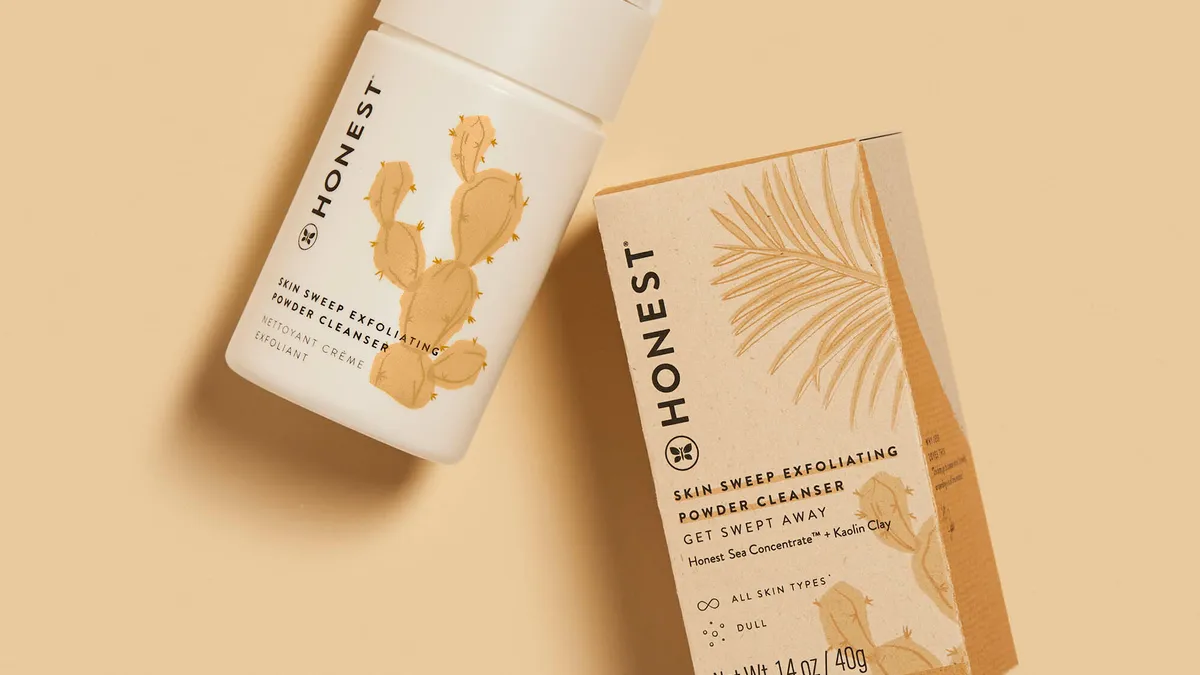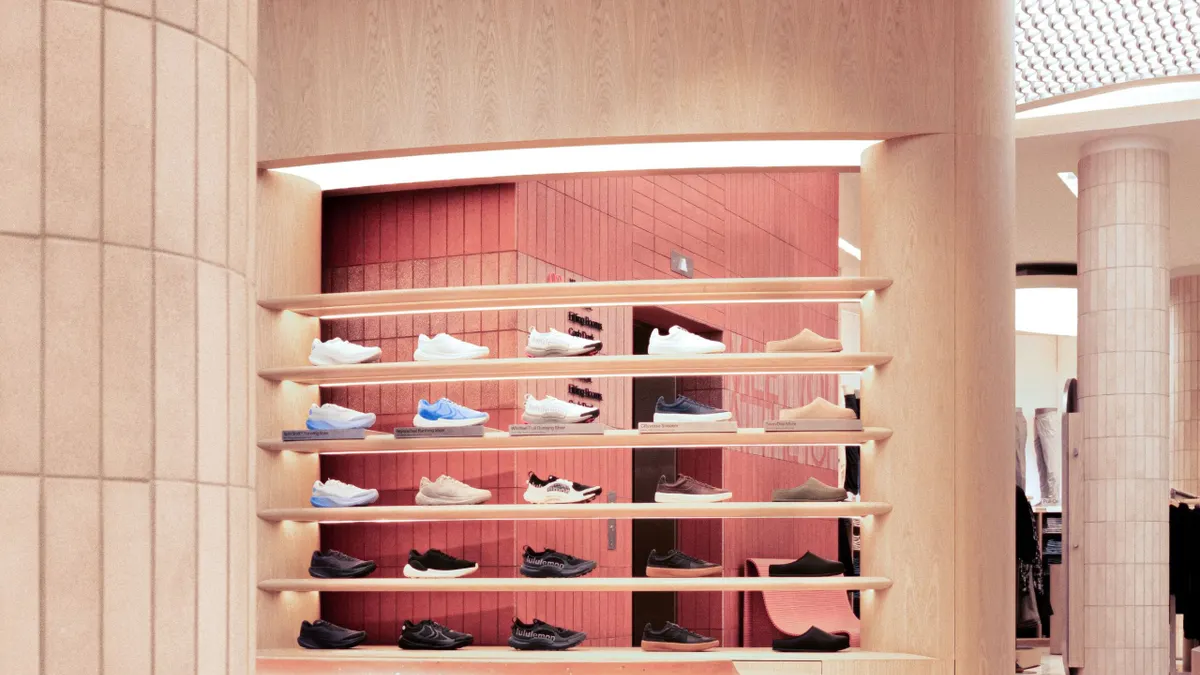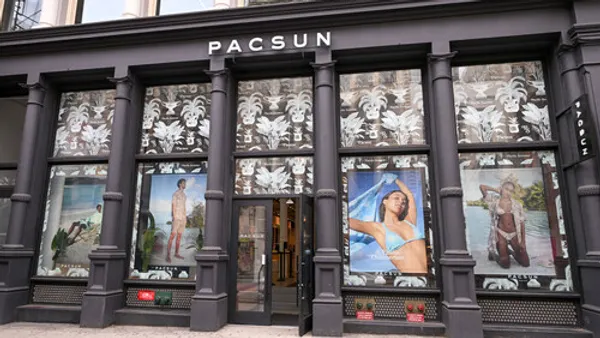It’s been nearly two years since Vuori announced ambitious plans to open 100 stores by 2026 and expand into international markets.
The announcement came as the activewear brand raked in a whopping $400 million investment at a $4 billion valuation from SoftBank Vision Fund 2. Vuori has remained profitable since 2017, the company told Retail Dive.
And despite other direct-to-consumer brands pulling back on their own retail expansions — Allbirds, for example, earlier this year announced it would slow down store openings as the DTC footwear brand executes on its transformation plan — Vuori’s Vice President of Retail Catherine Pike said the brand is on track to reach its goal.
“We are seeing great engagement and excitement from our local customers, which has encouraged us to continue our expansion plans in the U.S.,” Pike said in an email to Retail Dive.
The brand now operates around 40 stores globally, quadrupling its store footprint since it announced its brick-and-mortar plans in October 2021.
Vuori has steadily expanded its footprint over the past two years
In that time, Vuori has opened in new markets, including Austin, Texas; Boston; Chicago; London; and more recently, Bethesda, Maryland, just outside of Washington, D.C.
“Community is an important pillar of Vuori. When opening in new markets, we look to our existing engaged community in these locations, while considering the ways in which we can introduce the brand to new local customers in the market,” Pike said
The stand-alone stores represent “the ultimate manifestation of our brand and our community centered ethos,” according to Vuori founder and CEO Joe Kudla.
While leaning into its own stores has been valuable to Vuori, the company took an unconventional path when it entered the market. The brand, which was founded in 2015, initially started out by selling its products to third-party fitness studios in order to acquire customers.
“When we originally launched the business we sold primarily to fitness studios to connect directly with people wearing the product at the point of activity, catering specifically to men who were often underserved in this category,” Kudla said in an email. “With that said, we quickly found this channel to be challenging to build a business around on its own and the larger retailers weren’t quite ready to get behind premium mens activewear.”
This led the brand to launch its DTC channel. Vuori’s own channels have allowed it to connect with its customers to hear feedback.
"Having stores is another way to get people to learn about your brand and become a fan, and also allows you to have a deeper relationship with your current customer."

Matt Powell
Adviser at Spurwink River
In addition to serving as a point of contact for consumers to interact with brands, another major reason DTC companies turn to brick-and-mortar retail is to help bolster their marketing efforts.
“Many brands use their own retail stores more as a marketing tool, and less as a commerce tool. They want to be places where people are going to see the product,” Matt Powell, adviser at Spurwink River, told Retail Dive. “One of the big challenges for DTC brands is customer acquisition. It's hard to get a new customer to come to you unless you've got really strong word of mouth or social media marketing. So having stores is another way to get people to learn about your brand and become a fan, and also allows you to have a deeper relationship with your current customer.”
Vuori's new Bethesda location shares a street with other popular DTC brands
And while 100 locations may seem like a lofty goal, especially as other retailers announce store closures, the number of locations isn’t necessarily what’s important as long as the brand is being thoughtful about where it’s opening its stores, according to Nora Kleinewillinghoefer, a partner in the consumer practice of Kearney.
“As we think about retailing right now and brick and mortar, it is secondary locations that are struggling, it's not the primary locations necessarily. It's about being in the right place with your consumer, not just being everywhere,” Kleinewillinghoefer said, adding that stores can be places “where you can talk to somebody about the brand, you can tell your stories, but you can also leverage the more expanded DTC online presence or e-commerce channel to create that breadth of assortment — it doesn't have to be in the retail format. So if you're thoughtful about the format, location and execution, I don't think opening new retail is a problem.”
How early wholesale adoption led Vuori to success
Vuori has also steadily built out its roster of wholesale partners over the years in order to further expand its reach.
“While our early adoption of a direct strategy has served as a big catalyst for our success, partnering with the best retailers across several of [the] industries that are relevant to our customer … has helped ensure we show up where our customers are and provides valuable perspective on how Vuori sits in the market relative to other great brands,” Kudla said.
"The question for us was not whether or not to sell wholesale, but rather how we go about doing it.”

Joe Kudla
CEO and Founder of Vuori
The brand now sells in retailers from Nordstrom and REI to fitness studios like Equinox, as well as independent outdoor and running stores.
“Embracing wholesale early in our life cycle was a big part of our success. We were a bootstrapped business that started in a garage so we had to find efficient ways to share our product and our story with our customers,” Kudla said, adding that a holistic, multi-channel strategy where the company could stay “in control of our business at wholesale” would allow it to drive awareness for its online business. “The question for us was not whether or not to sell wholesale, but rather how we go about doing it.”
For Vuori, wholesale has also allowed the company to introduce the brand to a more niche customer base and then continue to connect with that consumer down the line at Vuori’s own stores, which feature a wider, more diverse product offering, according to Pike.
DTC brands can learn a lot from their wholesale partners, particularly those retailers that have been operating for a while, according to Kleinewillinghoefer. The retailers not only extend the reach for smaller brands, but they also can teach brands about product placement and storytelling.
“They can create visibility for you in much more effective ways than if you're just going DTC and trying to do it on your own,” Kleinewillinghoefer said.
Standing out in a saturated market
Vuori’s brick-and-mortar plans come off the back of heightened demand in the activewear market. But its early popularity came well before that and it was largely due to what consumer segment it was going after.
“So many of the activewear brands in the marketplace right now are focused on the women's side because they're all chasing Lulu and the success that's been there,” Powell said. “Vuori — it's not entirely a men's focus — but having more of a men's focus set them apart a little bit.”
In recent years, retailers selling activewear and athleisure thrived during the onset of the pandemic as more consumers sought out healthier lifestyles, and apparel became more casual as people started working from home. However, as with many successful things, this led to increased competition.
“With the amount of noise that we're all seeing, everyone can create a cost-effective T-shirt. Creating a product is not the problem. It's differentiating yourself with the storytelling, the quality and the connectivity to the customer,” Kleinewillinghoefer said. “I think Vuori has been making a big splash by being very controlled about how they show up [and] where they show up, particularly when it comes to partnerships like wholesale.”
And while the return to office has contributed to more structured apparel becoming more prominent than during the pandemic, comfortable athleisure styles aren’t going away anytime soon.
“We've completely shifted what’s work appropriate. Work from home is still a very real thing. We are still much more hybrid than we were prior to the pandemic,” Kleinewillinghoefer said. “The acceptability of a more leisurely dress code when you're in your home, for example, is completely changed. Nobody's expecting somebody to sit in their home wearing a dress shirt because there’s just no reason to.”
However, despite the reintroduction of dressier styles driven by a resurgence of in-person events and reopening of offices, there is still solid demand for activewear, Powell added.
“I think a lot of people are really misreading that trend and they're making the assumption that he's going into his closet and throwing all of his hoodies away and buying suits and dress shirts and that's simply just not happening. Did he go out and buy one or two suits for events and maybe for work? Yes, but he's not throwing out his entire activewear wardrobe,” Powell said.
To stay relevant, Vuori has formed partnerships with other brands, including with Clae for footwear and Bala. The brand is also prepping new product launches later in the year.
“Moving into the back half of the year we have some exciting new products that will be launching, with a focus on innovative new fabrics that we can’t wait to introduce to our community as well as expanding in some new exciting categories,” Kudla said.























